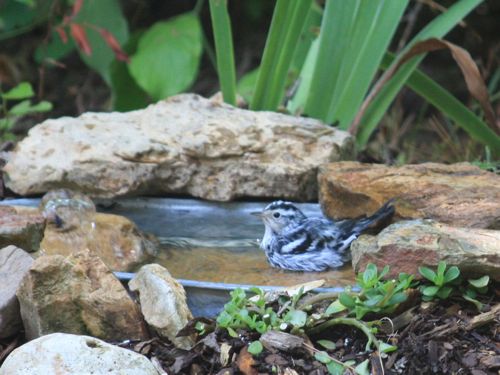Cow lily, found wild in the Louisiana swamps.
Question:
I'm from Ann Arbor, Michigan, USA. This is my third year with a water garden and I love it! I have a small pond - 50 gallons in a preformed liner with a small pump/fountain that I've made sure doesn't splash onto my lilies. I have a corkscrew rush, pickerel rush, and water lettuce plus my lilies. My pond usually gets between 6 and 8 hours of direct sunlight a day.
Last year I had some problems with my water lily not blooming. We did have a colder than usual summer last year and the lady at my local pond supplier suggested that it could either be because of that or because my lily needed to be repotted/divided.
This spring, I divided the lily and repotted the two halves. I had to wait longer than I really wanted to because we had a very chilly spring, but I finally got it repotted and into the pond around the end of May/beginning of June which was the first time we had temps stay above 50 in the evenings. Half #1 is doing MARVELOUSLY. There's lots of new growth, large pads and I fully expect to see buds/blooms any day now. Half #2 is not doing so hot. There are some small green leaves close to the rhizome, but only 2 leaves have reached out towards the surface and they were very small and yellow and didn't last long.
At first I thought maybe it was getting splashed even though I had tried to make sure it wasn't, so I switched fountain heads to further control the fountain and now it is DEFINITELY not getting splashed. Next I thought perhaps it just needed time and fertilizer, but it's been about 6 weeks now and it's not thriving any more than it was.
Tonight, I moved it to a separate tub with some of the pond water along with some fresh water because I'm really afraid there's something seriously wrong with it and if there is, I don't want it to infect the other lily.
I've checked for bugs and other than a few water snails along the side of my pond, I can't find any evidence of bugs. The rhizome doesn't smell rotten so I don't *think* it's crown rot, but I didn't want to take chances.
Could it just be that my pond is too small for two water lilies to flourish? Or am I doing something wrong? Or is there really something wrong with my lily?
Any help/advice that anyone could give me would be *greatly* appreciated. I've searched all my books and I can't find any answers so I thought I'd search online.
Thank you for any help you can give!
Answers:
Yup, your pond is too small for two lilies. Are you fertilizing the lilies? You need to push in 1 Pondtabb per gallon of pot at least once a month. They really like a tab twice a month, but then you will have a gigantic lily.
Add dechlor if you put the plant in fresh water. The chemicals our city fathers put in our drinking water is a crime.
Continued conversation:
Thanks for replying! I'm glad to hear that it's just that my pond is too small and that there's nothing necessarily wrong with the other lily.
Yes, I fertilize my lilies with Pondtabbs (all my plants actually). I did add some "Pond Start" which is supposed to take care of all those lovely chemicals, though I don't have nearly as many as those with city water because I'm on a well, but I figured better to add it and not need it than to not add it and be sorry!
More about waterlilies
I am in the UK and have a waterlily which I found by the roadside therefore I have no idea what it is I have it in a bath which we have on our allotment,which is used as a pond for wildlife I think it has outgrown it as the leaves are high up the sides I have another bath there which like this one is home to all sorts of tadpoles and other creatures, should I wait until winter to divide it as I have never done this before and it is not in a pot I found it in what looks like a canvas wrap or bag
More answers:
Wait until spring to divide it.
My guess is that it's a hardy lily as opposed to a tropical one or it wouldn't have been growing wild. You will find that if you just plant it in the water and not put it in a pot, it will take over and you will have a hard time getting rid of it after a few years.
You can remove leaves as they get out of hand and not harm it. It should be blooming now. The blooms will probably be yellow or white and look wonderful.
Continued conversation
They are white with a yellow centre, it was actually dumped not in the water when I found it too so I'm surprised it survived, they are gorgeous though
And answers:
They are pretty hard to kill, being not much more than weeds. You will love it.
Read about water lilies in my best selling book, "A Practical Guide to Building and Maintaining your Pond" available from Amazon
here.
And join us at our interactive pond forum
here.















































